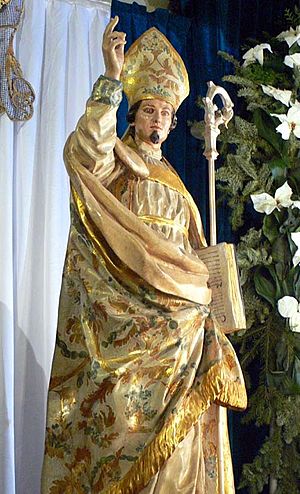Fulgentius of Cartagena facts for kids
Quick facts for kids SaintFulgentius of Cartagena |
|
|---|---|

Image of Saint Fulgentius in the major church of Cartagena. Sculpture by Francisco Salzillo. 18th century.
|
|
| Born | 6th century Cartagena, Hispania |
| Died | c. 630 Astigi, Hispania |
| Venerated in | Roman Catholic Church Eastern Orthodox Church |
| Feast | 14 January |
Saint Fulgentius of Cartagena (also known as San Fulgencio de Cartagena) was an important religious leader who lived a long time ago. He was born in Cartagena, a city in what is now Spain, sometime in the 500s. He later became the Bishop of Ecija (which was called Astigi back then) and passed away around the year 630.
His Life and Family
Fulgentius came from a very religious family. His brothers, Leander of Seville and Isidore of Seville, both became important Archbishops of Seville. Leander was older than Fulgentius, and Isidore was younger. They also had a sister named Saint Florentina. Their father, Severianus, lived in Cartagena and was a Roman citizen.
We don't have many exact details about Fulgentius's life. He is only mentioned a few times in old writings. For example, his older brother Leander once wrote that he had sent Fulgentius back to Cartagena. Leander was worried about Fulgentius and asked their sister Florentina to pray for him. We don't know what danger Fulgentius was in at that time.
Becoming a Bishop
Thanks to his brother Leander, who was a powerful Archbishop in Seville, Fulgentius became the Bishop of Astigi (Ecija). This city was part of the church's area in Seville.
Leander became Archbishop in 584 and died in 600. We know that another bishop, Pegasius, was still in charge of Ecija in 590. So, it's likely that Fulgentius became bishop sometime between 590 and 600.
Important Events
In 610, Fulgentius signed a special order from King Gundemaro. This order created a new church province in Toledo, taking land from the Cartagena area. At that time, Cartagena was under the rule of the Byzantines.
His younger brother, Isidore, who took over as Archbishop of Seville after Leander died, wrote a book for Fulgentius. The book was called "De ecclesiasticis officiis" and was about how church services were done. Isidore wrote this book because Fulgentius asked him to.
In 619, Fulgentius attended an important meeting called the Second Synod of Seville. A synod is a meeting of church leaders. At this meeting, there was a disagreement between Fulgentius and the Bishop of Córdoba. They both claimed a certain church belonged to their area. The leaders at the synod decided that if someone had owned a church for 30 years without anyone arguing about it, they could keep it. Fulgentius signed the papers from this meeting. This is the last thing we know for sure about his life. He died before the year 633.
Veneration and Legacy
Like his brothers and sister, Fulgentius was honored as a saint. In Spain, his feast day (a special day to remember him) is celebrated on different dates, but it's often on January 14.
Sometimes, old writings confuse Fulgentius of Cartagena with another saint named Fulgentius of Ruspe. Some books were also thought to be written by him, but we don't have any copies of them today.
It is believed that long after Fulgentius and his sister Florentina died, some of their bones were moved to a safe place in the mountains called the Sierra de Guadalupe. In the 1300s, these bones were found in a village called Berzocana. Other parts of their bones are kept in the Cathedral of Murcia in Cartagena. Fulgentius is considered the patron (a special protector) of the Cartagena area.
See also
 In Spanish: Fulgencio de Cartagena para niños
In Spanish: Fulgencio de Cartagena para niños

